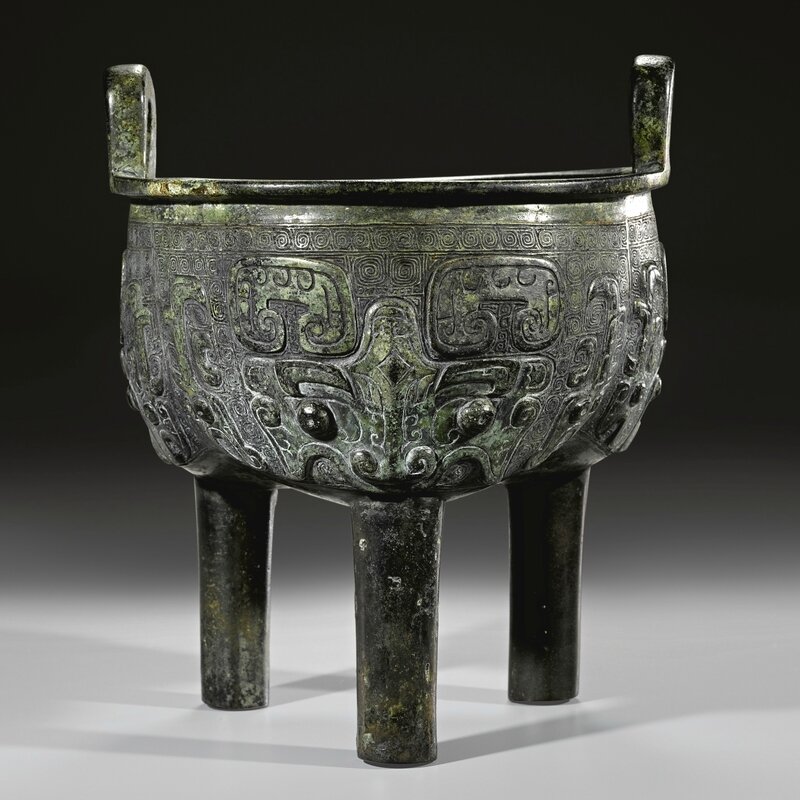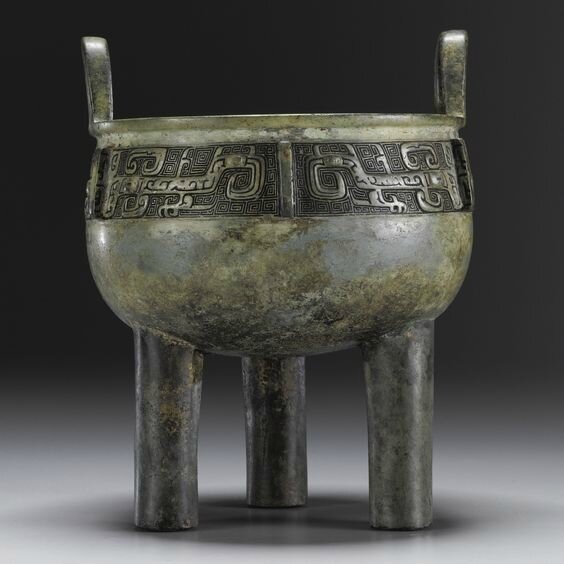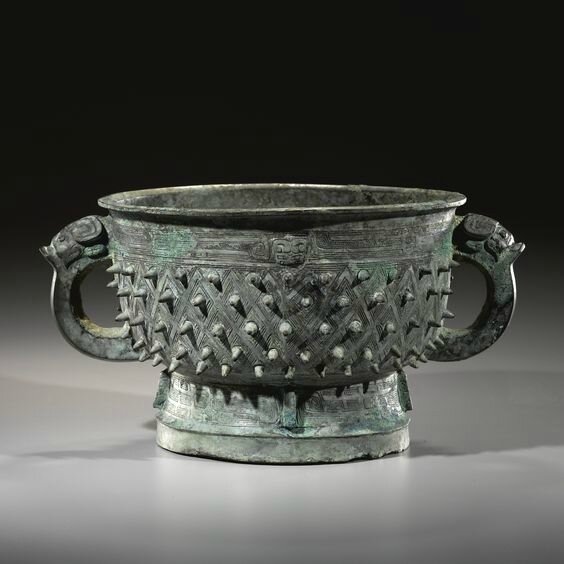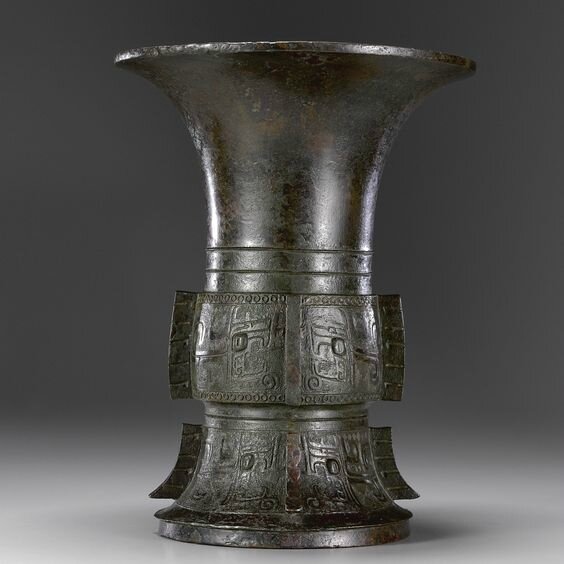Archaic bronze sold at Sotheby's New York, 15 sept. 2010
Lot 270. A fine archaic bronze ritual food vessel, liding, Late Shang dynasty (c. 1600 BC–c. 1046 BC); height 8 1/4 in., 21 cm. Estimate 50,000 — 70,000. Lot sold 116,500 USD. Photo: Sotheby's 2010
standing on three cylindrical legs with steeply rounded sides divided into three lobes, each lobe cast in raised relief with a taotie mask formed from raised bosses for eyes and hooked scrolls accented with intaglio lines reserved on a fine leiwen ground, the lipped rim with two upright loop handles of rectangular section.
Provenance: Old Japanese Collection.
Lot 271. An archaic bronze ritual food vessel, ding, Shang dynasty, 12th-11th century BC. Estimate 30,000 — 50,000. Lot sold 92,500 USD. Photo: Sotheby's 2010
the deep U-shaped body supported on three columnar legs and set with two upright loop handles on the everted rim, cast below the lip in low relief with a single band with segmented taotie animal masks separated by flanges, all reserved on a leiwen ground, the silvery surface with light malachite and cuprite patination.
Provenance: John Sparks, London.
Mathias Komor, New York, 1957 (according to label).
Note: The sunken areas of the design on this bronze contain carbon, a practice common to Shang bronzes and deliberately applied after casting to emphasize the surface decoration.
Lot 272. An archaic bronze ritual food vessel, ding, Late Shang dynasty (c. 1600 BC–c. 1046 BC); height 7 3/4 in., 19.7 cm, width 6 1/4 in., 15.8 cm. Estimate 40,000 — 60,000. Lot sold 86,500 USD. Photo: Sotheby's 2010
the body of deep rounded U-shape resting on three cylindrical legs, crisply cast around the exterior with a wide band of three ferocious taotie masks divided by confronted kui dragons, above a skirt of triangular lappets set with pendent cicadas against a leiwen ground, the rim set with two loop handles, a single pictogram to the inside rim, the metal patinated to a dark grey tone with patches of malachite encrustation.
Provenance: Old Japanese Collection.
Lot 273. A fine archaic bronze ritual food vessel, gui, Late Shang dynasty (c. 1600 BC–c. 1046 BC); width across handles 12 1/8 in., 31 cm. Estimate 60,000 — 80,000. Lot sold 98,500 USD. Photo: Sotheby's 2010
the deep rounded sides with flattened everted rim, the body set with a pair of loop handles springing from bovine-masks, decorated with a broad band of raised bosses on a ground of diamond shapes below a narrow band of four stylized kui dragons in low relief separated by two animal masks, all supported on a hollow pedestal foot encircled by a band of confronted stylized kui dragons, inscribed to the center of the interior with a single pictogram, all beneath a silvery patina with rich green malachite encrustation.
Provenance: Old Japanese Collection.
Note: Designs incorporating bosses framed by diagonal lines enclosing leiwen appear to have been used mostly on round-bodied vessels from the Anyang period, as a number of examples discovered in the tomb of Fu Hao demonstrates. They appear, however, more commonly on bronze vessels excavated from sites in Shaanxi province as Jessica Rawson notes. See Jessica Rawson, Western Zhou Ritual Bronzes from the Arthur M. Sackler Collections, Vol. IIB, Washington, D.C., 1990, p. 378. Bronze vessels with handles such as this gui, are rarer. Compare an example excavated from Liquan Xian in Shaanxi province, illlutratated ibid., p. 378, fig. 41.1.
Lot 274. An archaic bronze ritual wine vessel, zun, Late Shang dynasty-Early Western Zhou dynasty, 11th century BC; height 11 7/8 in., 30.1 cm. Estimate 80,000 — 100,000. Lot sold 146,500 USD. Photo: Sotheby's 2010
of tall circular form with a wide trumpet mouth and raised splayed foot, the long flared neck plain, the central bulb cast in low relief with a frieze of confronting dragons, divided and interspersed with notched vertical flanges, between narrow bands of circles, the lower bulb cast with a similar design frieze, the bronze a warm golden-brown patina with patches of green malachite and red cuprite encrustation, the inside of the foot cast with a long inscription.
Provenance: Collection of C. L. Rothenstein, Bradford (according to label) who in 1914 changed his name to Charles L. Rutherston.
Bluett & Sons, London (according to label).
Exhibited: International Exhibition of Chinese Art, Royal Academy of Arts, London, 1935-6, cat. no. 182.
Literature: Catalogue of the International Exhibition of Chinese Art 1935-6, Royal Academy of Arts, London, 1935, p. 14, no. 182 and International Exhibition of Chinese Art 1935-6: Illustrated Supplement to the Catalogue, Royal Academy of Arts, London, 1935, p. 16, fig. 182.
Note: Charles Lambert Rutherston (1866-1927) was the brother of Sir William Rothenstein, Principal of the Royal College of Art, connoisseur, collector and one of the first patrons of Henry Moore, who upon visiting Rutherston in 1923 noted that he had one of the most important collections of Chinese art in Britain.
Lot 275. An archaic bronze ritual food vessel, gui, Shang dynasty-Western Zhou dynasty; height 5 1/4 in., 13.3 cm: width across handles 10 1/4 in., 26 cm. Estimate 60,000 — 80,000. Lot sold 62,500 USD. Photo: Sotheby's 2010
the rounded sides cast with a band of vertical ribs below a frieze of flaming squares alternating with circles and divided by raised animal heads, all on a leiwen ground, the sides set with a pair of loop handles issuing from dragon heads and set with hooked pendant tabs, all supported on a hollow upright foot decorated with a band of taotie masks with raised eyes divided by flanges, the center of the interior with an inscription comprising five pictograms, the bronze patinated to a smooth olive-green patina.
Provenance: Collection of J. R. H. Johnson, Esq., London.
Sotheby's London, 15th December 1981, lot 11.
Lot 276. An archaic bronze ritual food vessel, gu, Shang dynasty, 12th century BC; height 13 5/8 in., 32.2 cm. Estimate 40,000 — 60,000. Lot sold 52,500 USD. Photo: Sotheby's 2010
of tall slender waisted form, the flaring neck with a wide trumpet mouth finely cast with four tapering blades each containing a disjointed taotie mask set upside down on a fine leiwen ground, the straight central section and gently flared foot both similarly decorated with taotie masks assembled from isolated raised elements on a fine leiwen ground and bisected by notched flanges, the surface a a matte light green with areas of brown and green encrustation.
Provenance: Old Japanese Collection.
Note: A gu published by Robert W. Bagley in Shang Ritual Bronzes in the Arthur M. Sackler Collections, Washington, D.C., 1987, p. 248, no. 36, is similarly decorated with taotie masks assembled from isolated raised elements and covered with leiwen spirals. This special design feature is characteristic of bronze designs classified by Max Loehr as 'Style Va'. A number of gu and jue recovered from sites of the latter Anyang period at Anyang demonstrate that 'Style Va' designs were well suited to these two vessel types. See ibid., pp. 249-250 and p. 255.
Lot 277. An archaic bronze ritual wine vessel, zun, Western Zhou dynasty, 11th-10th century BC; height 8 1/8 in., 20.6 cm. Estimate 5,000 — 7,000. Lot sold 9,375 USD. Photo: Sotheby's 2010
the pear-shaped body rising from a short spreading foot to a widely flaring neck, crisply cast around the shoulder with a band of confronting dragons on a leiwen ground divided by two animal masks, the bronze an attractive black color with some areas of malachite encrustation.
Property of the Arthur M. Sackler collections.
Note: A similar design band but with a different animal mask, with pointed ears, can be found on a zun in the Freer Gallery of Art, illustrated in John Alexander Pope et al., The Freer Chinese Bronzes, Washington, D.C., 1967, pl. 73. Similar decoration can also be found on a four-legged you and a four-legged zun of oval section discovered in the tomb of Yu Bo Ji of the early to middle Western Zhou period at Baoji, Shaanxi province, where they were placed on a lacquer tray; see, for example, Jessica Rawson, Western Zhou Ritual Bronzes from the Arthur M. Sackler Collections, Washington, D.C., 1990, p. 35, figs. 31 and 32.
Lot 279. An archaic bronze ritual wine vessel, jue, Shang dynasty (c. 1600 BC–c. 1046 BC); height 7 1/8 in., 18 cm. Estimate 15,000 — 25,000. Lot sold 26,250 USD. Photo: Sotheby's 2010
the deep U-shaped body finely cast with a band of taotie masks reserved on a dense leiwen ground, one side set with a loop handle concealing two pictograms, beneath a long channeled spout opposite a raised point forming the rim, surmounted by a pair of rectangular posts rising to mushroom-cap finials decorated with whorl patterns, all supported on three slightly splayed blade feet, the surface covered with areas of light malachite patina.
Provenance: Old Japanese Collection.
Lot 280. A finely cast bronze chariot fitting, Western Zhou dynasty (c. 1046-771 BC); length 8 1/8 in., 20.6 cm. Estimate 15,000 — 20,000. Lot sold 40,000 USD. Photo: Sotheby's 2010
the tong tapered cylindrical body cast with finely detailed elongated blades bordered by a band of confronted dragons on a leiwen ground, the lynch pin cast in the form of an elaborate feline mask, the bronze with some green encrustation (3).
Lot 281. A small bronze belt, Western Zhou dynasty (c. 1046-771 BC); height 4 1/4 in., 10.7 cm. Estimate 2,000 — 3,000. Lot sold 1,875 USD. Photo: Sotheby's 2010
of elliptical section and barrel form with a crescent-shaped opening, each side cast with a stylized taotie in a raised line relief, set with a loop handle for suspension.
Sotheby's. Fine Chinese Ceramics & Works of Art, New York, 15 sept. 2010

/https%3A%2F%2Fprofilepics.canalblog.com%2Fprofilepics%2F1%2F0%2F100183.jpg)
/https%3A%2F%2Fstorage.canalblog.com%2F03%2F02%2F119589%2F96711876_o.jpg)
/https%3A%2F%2Fstorage.canalblog.com%2F11%2F31%2F119589%2F94773502_o.jpg)
/https%3A%2F%2Fstorage.canalblog.com%2F20%2F83%2F119589%2F94772815_o.jpg)
/https%3A%2F%2Fstorage.canalblog.com%2F26%2F72%2F119589%2F75604929_o.jpg)
/https%3A%2F%2Fstorage.canalblog.com%2F59%2F60%2F119589%2F26458628_o.jpg)



















/image%2F1371349%2F20240406%2Fob_b23648_434058570-1644317966338216-88086167391.jpg)
/image%2F1371349%2F20240403%2Fob_6d5ae7_dp-28103-001.jpg)
/image%2F1371349%2F20240229%2Fob_8f31f9_431013694-1625286614908018-33034430839.jpg)
/http%3A%2F%2Fstorage.canalblog.com%2F79%2F20%2F119589%2F129837997_o.jpg)